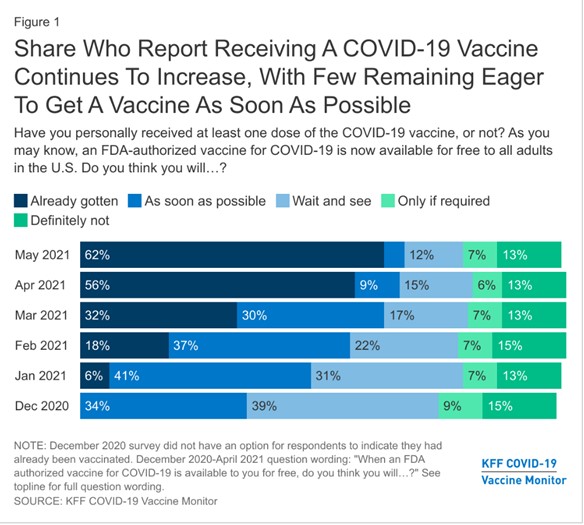On June 2, President Biden announced National Month of Action - a new federal push to reach the current COVID-19 vaccination goal of 70% of U.S. adults inoculated with at least one COVID-19 vaccine by July 4. This new vaccine drive offers incentives, ranging from free beer to free childcare, to entice Americans to get their shots –and to make it easier for them to do so. The call for a national vaccine drive emphasized the role each one of us can play in reaching those members of our communities that have yet to get vaccinated.
While June 2021 was labeled “National Month of Action” in the latest presidential announcement, many milestones have already been reached. These include securing adequate vaccine supply for every American, establishing eligibility for adolescents 12 years old and older and creating a vaccination site within 5 miles of home for 90% of the population.
While these recently announced actions and incentives have no direct impact on employer strategies, they do put a laser-like focus on how the efforts to reach unvaccinated people are evolving and intensifying, and how employer strategies can complement them.
Current Vaccination Rates and the Outlook for Achieving the Goal
The Centers for Disease Control and Prevention (CDC) has reported that the percent of adults vaccinated with at least one dose was 63% as of early June1. That good news, however, is overshadowed by the fact that the rate of daily vaccinations has been declining steadily.
Kaiser Family Foundation (“KFF”) data show that the percent of those ready to get the vaccine as soon as possible is rapidly shrinking, as most who wanted the vaccine have already gotten one. The percentage of the adult population unwilling to get vaccinated has remained constant, at about 20%, since January 2020. As a result, the pool of adults who can be influenced by existing strategies within the time remaining to reach the goal is limited (Figure 1).
In addition, there is a growing concern that certain states and localities with the lowest vaccination rates are at risk for an outbreak, especially as safety measures and travel restrictions ease:

There is a strong reverse correlation between the infection rate and vaccination status. The highest rates of new COVID-19 cases are beginning to occur in the states and counties with the lowest vaccination rates3. Therefore, reaching the national goal of 70% will likely require targeted efforts focused on states and localities where the greatest barriers and lowest confidence levels persist.
Here are some examples of what employers can do to support the vaccine drive:
- Seek to understand specific reasons why some employees may have concerns about vaccination and then strive to address them. KFF data show that the vaccine’s side effects and misunderstandings about vaccination cost to patients are leading concerns among those still on the fence. Employers can be another trusted source in sharing accurate, timely and targeted messaging explaining the risk of COVID-19 to all populations. Offering scheduling flexibility and sick leave for dealing with side effects and confirming that vaccine costs are fully covered for those on any health plan, as well as for those who may be uninsured, can go a long way in easing some of the key concerns.
- Empower your employees, especially managers, well-being champions, and members of employee resource groups (ERGs), to share why they got vaccinated and their experiences with the process. Fact-based and respectful conversations about vaccines in the workplace are appropriate.
- Create positive messaging about the benefits of vaccination, speaking not of hesitancy but of how the vaccine will help end the pandemic. Messaging can emphasize common purpose, solidarity among team members and the importance of getting vaccinated not only for their health and health of their families, but also to protect those most vulnerable among us.
- Empower employees to voluntarily share their vaccination status and demonstrate support for vaccination of their teammates.
- Understand where the biggest vaccination gaps are by monitoring state- level data and then concentrating efforts, such as communications, offering incentives tied to local experiences or offering on-site vaccination in areas of greatest need are just a few examples of local strategies.
- Create culturally sensitive communications to reach employees of all races, faiths and beliefs in a way that will resonate with these different populations.
Related Business Group on Health Blogs
- The Case for COVID-19 Vaccination Incentives in the U.S.
- Building COVID-19 Vaccine Confidence Through Culturally Conscious Messaging
References
- 1 | COVID Data Tracker. Trends in Number of COVID-19 Vaccinations in the US. Centers for Disease Control and Prevention. June 8, 2021. https://covid.cdc.gov/covid-data-tracker/#vaccination-trends. Accessed June 8, 2021
- 2 | Stolberg SG. Biden, facing July 4 deadline, rallies nation with vaccination incentives. The New York Times. June 4, 2021. https://www.nytimes.com/2021/06/02/us/politics/biden-vaccination-incentives.html. Accessed June 8, 2021.
- 3 | McPhillips D, Cohen E. Uneven vaccination rates across the US linked to Covid-19 case trends, worry experts. CNN. May 19, 2021. https://www.cnn.com/2021/05/19/health/uneven-vaccination-rates-covid-19-trends/index.html. Accessed June 8, 2021
